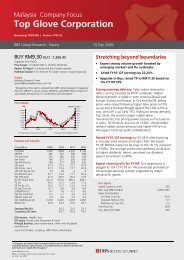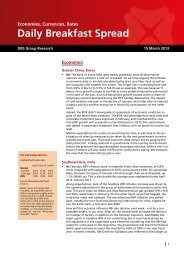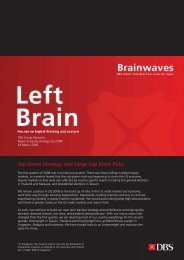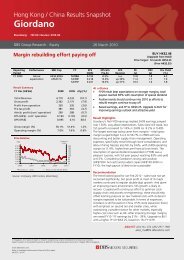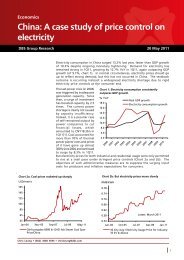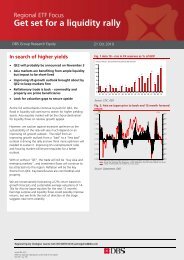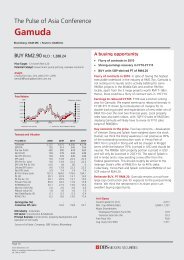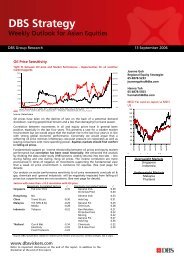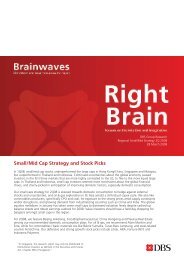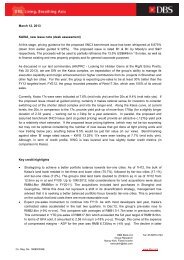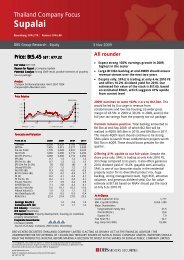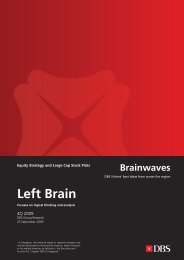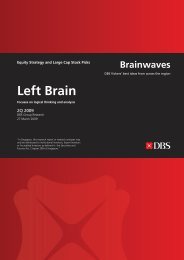Economics Markets Strategy - the DBS Vickers Securities Equities ...
Economics Markets Strategy - the DBS Vickers Securities Equities ...
Economics Markets Strategy - the DBS Vickers Securities Equities ...
Create successful ePaper yourself
Turn your PDF publications into a flip-book with our unique Google optimized e-Paper software.
<strong>Economics</strong>: Thailand<br />
<strong>Economics</strong> – <strong>Markets</strong> – <strong>Strategy</strong><br />
short-term. However, as we discussed in <strong>the</strong> previous paragraph, both <strong>the</strong> coup<br />
and <strong>the</strong> general elections have failed to bring political stability, revealing instead<br />
<strong>the</strong> deep divisions in Thai society at present. This means that confidence that<br />
<strong>the</strong> political mess can be resolved in <strong>the</strong> future should begin to fade. This may<br />
drag <strong>the</strong> “future” confidence sub-index down towards <strong>the</strong> “present” index at<br />
some point. This, in turn, is negative for <strong>the</strong> longer term outlook. Thankfully,<br />
we can still count on <strong>the</strong> relatively healthy labour market and strong farm<br />
incomes in 1Q08 to support consumption spending at around 3%.<br />
Investment - expected only in export oriented sectors where capacity is tight<br />
In 1Q08, investment spending began to turn around (Chart 5) in light of elevated<br />
capacity utilisation rates and pent up demand, especially in export-oriented<br />
sectors. Indeed, business sentiment, especially with regards to investment turned<br />
around sharply according to a BoT survey (Chart 6).<br />
Chart 5: Investment vs capacity utilisation<br />
% YoY %<br />
20<br />
77<br />
Chart 6: Business sentiment: investment sub-index<br />
Index<br />
58<br />
15<br />
10<br />
5<br />
75<br />
73<br />
71<br />
56<br />
54<br />
52<br />
50<br />
0<br />
-5<br />
Gross capital formation<br />
Capacity Utilisation<br />
Mar-03 Mar-04 Mar-05 Mar-06 Mar-07 Mar-08<br />
69<br />
67<br />
48<br />
46<br />
Mar-00 Mar-02 Mar-04 Mar-06 Mar-08<br />
However, <strong>the</strong> renewed spike up in political uncertainty implies that fur<strong>the</strong>r<br />
recovery in investment should be restricted to sectors and companies with very<br />
high capacity utilisation where orders cannot be met unless capacity is expanded.<br />
Capacity utilisation is now running above 90% in some sectors such as electrical<br />
and electronic, food, chemicals and paper (Chart 7). This should help support<br />
investment spending growth at 5%-6%, a little better than <strong>the</strong> 3% growth seen<br />
in 2006 and 2007, but disappointing none<strong>the</strong>less.<br />
Chart 7: Capacity utilisation - 90% in many sectors even as headline rate is not high<br />
%, 4qma<br />
105<br />
Mar-05<br />
Mar-08<br />
100<br />
95<br />
90<br />
85<br />
80<br />
75<br />
70<br />
65<br />
60<br />
Paper Chem Petro<br />
pdts<br />
IC<br />
Disk<br />
drives<br />
Zinc<br />
Comm.<br />
Car<br />
Tyre<br />
Wshg<br />
Mach<br />
116



